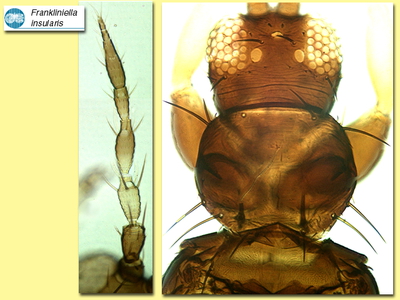Figures
Fig. 1 Antenna, head and pronotum
Fig. 2 Fore and hind wing
Fig. 3 Meso- and metanotum
Fig. 4 Tergite VIII (female)
Species
Frankliniella insularis FranklinBiology
Polyphagous neotropical flower-living species that is possibly a pest in the flowers of the legume crops Cajanus and Pachyrhizus in Central America. Often found in large numbers within the rolled petals of the flowers of Malvaviscus.
Distribution
Throughout much of South and Central America and the Caribbean into the southern States of USA including Florida and California.
Recognition
Body colour dark brown, fore tibiae and tarsi yellow, also at least basal part of antennal segments III-V; forewing brown with sub-basal area clear. Head broad, frontal margin straight; 3 pairs of ocellar setae present, III on anterior margins of ocellar triangle; major postocular setae more than half as long as ocellar III setae. Antennae 8-segmented, III & IV with forked sense cone, VI with elongate base to external sense cone. Pronotum with 2 pairs of long setae on anterior margin, 2 pairs of long posteroangulars, and one pair posteromedially. Metanotum with median setae arising at anterior margin. Forewing with both longitudinal veins bearing complete row of setae. Tergites V-VIII each with a ctenidium laterally, on VIII anterolateral to spiracle; tergite VIII posterior margin with a comb of microtrichia arising from triangular bases, but median 4 microtrichia usually absent. Sternites with no discal setae. Male similar to female; sternites III-VII with transverse glandular area; setae on IX & X sometimes stout.
Related species
Although this genus includes at least 160 species, F. insularisis usually distinguishable because of the broad head and the curious gap in the posteromarginal comb on tergite VIII.





